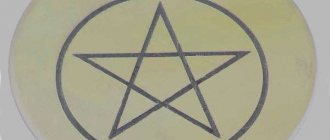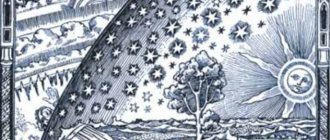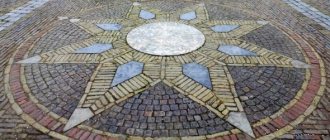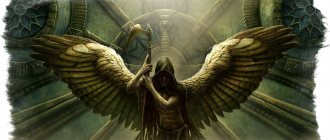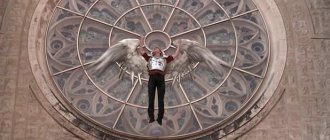The five-pointed star is more than 5 thousand years old
An interesting but little-touched topic is the symbolism of the five-pointed star.
This simple symbol is one of the oldest; it began to be used several thousand years BC. It has become widespread in many cultures and has a great meaning. The same star, differing only in color, is present in the symbolism of the United States, the European Union, the Soviet Union, China and many other countries and social movements. Since it is widely used to convey various meanings and ideas, for a better understanding of them, we will briefly consider some of its main meanings.
Andrey Rublev. Transfiguration. 1405 g
The oldest documented evidence of the use of a five-pointed star comes from the states of Sumer, found on the site of the ancient city of Ur in Mesopatamia and dated back to 3500 BC. In their writing, such a pictogram designated a corner, a small room, a hole.
The pentagram is found everywhere in the design of buildings, structures and household items in the Ancient East, Egypt, India, China and Japan.
Among the ancient Pythagoreans, the pentagram (from the word pentagramos - five-linear) meant five shelters where primeval chaos was placed during the creation of the world, and they were located in Tartarus. The darkness found in these refuges was considered the source of the soul of the world, as well as the source of wisdom. This pentagram was drawn with two rays upward.
The five-pointed star (pentagram) or pentalpha (as it can be decomposed into five letters “alpha”), with the light hand of Pythagoras and his followers, symbolized the harmony of the sacred union of heaven and earth. It was a symbol of the goddess of health Hygieia and served as a sign of the five human senses. For the Pythagoreans, such a star was a symbol of mathematical perfection, since it conceals the golden ratio (φ ≈ 1.618).
The symbol of the goddess who rules this other world is an apple, since when cut, you can see a pentagram in it. Therefore, the pentagram was also a symbol of health and the goddess Hygieia. In addition, Pythagoras argued that in geometry the pentagram is mathematical perfection. But without delving into the mathematical characteristics of this figure, let's move on.
In Kabbalah, a pentagram with one ray pointing upward signifies the Messiah. The pentagram is also a symbol of the seal of Solomon.
In 300-150 BC e. The pentagram was the emblem of Jerusalem.
Seal of the city of Jerusalem - 300 to 150 BC
For a Muslim, it can mean the five pillars of the Muslim faith and the five daily prayers.
In Christian Europe, the five-pointed star had a number of symbolic meanings. In addition to the symbol of health remaining from the times of the ancient world, it symbolized with five rays the five senses and five fingers. In religion, the pentagram was used as a symbol of the five wounds of Christ, the five joys of Mary, which the perfection of her son Jesus brought her. It also symbolized the Star of Bethlehem at Christmas (in Russia the Star of Bethlehem was seven-pointed).
One of the main meanings of the five-pointed star was the symbol of the humanity of Christ, so during the Renaissance, when man and the human personality began to take on more and more importance, this symbol also became more important. The five-pointed star resembles a man with arms extended to the sides and legs spread apart, similar to the drawings of Leonardo da Vinci. With the development of humanism and atheism, the star began to mean simply the human personality, as the new highest value of the new era.
The five-pointed star and humanistic ideals really became widespread during the Great French Revolution. With the advent of the new atheistic ideology, man was placed in first place in the value system, and the star in its humanistic meaning became one of the most important symbols. As a result of these changes, the star also became widespread in the military symbolism of first the French Republic, and then other countries. In this sphere, she symbolized the god of war, Mars, who, according to legend, was born from a lily, which resembles a five-pointed star. This sign is used for both identification and various other designations.
With the spread of the values and social forces of the new era, the five-pointed star began to spread. It has always been an important sign in the symbolism of the Freemasons, a social force that began to gain global significance after the French and American revolutions. In addition to ancient and occult meanings, the star began to be widely used by them to publicly express their ideas - the spiritual improvement of man and the elevation of man to the head of the entire value system in an atheistic version. Therefore, the star is widely used in the state symbols of many countries built according to Masonic drawings - the United States, where the stars on the flag also mean the Kingdom of Heaven, the European Union and others.
The five-pointed star is also used by many movements and organizations, its symbolism is often associated either with the Masonic forces behind them, or with the communist movement that has adopted it into its symbolism.
The star with two points up is used by the Latter Day Saints or Mormons. An inverted star with rays of different colors symbolizing the Star of Bethlehem is also the symbol of the largest fraternalist organization - the Order of the Eastern Star. This order unites about a million Masons at least at the rank of master and is known for its charitable activities.
An inverted pentagram with two rays upward is one of the main symbols of Satanists. Such a pentagram means Tartarus or hell, the place where fallen angels are imprisoned. Inside the inverted pentagram, the head of Baphomet is also often drawn in the form of a goat's head. All this symbolizes anti-human nature and the worship of animal passion. The three downward rays of the star also mean the rejection of the Holy Trinity.
Contrary to the common stereotype, the five-pointed star (pentagram) is not a symbol of the devil or Satan. its “negative” meaning to the demonologists of the Inquisition. It was during the period of witch hunts that the popular symbol began to be identified with the devil and Baphomet, and was associated with witchcraft and the forces of evil. Echoes of those times form the core of today's stereotype about the five-pointed star as a symbol of Satan.
The pentagram is also often found among pagans, serving them as one of the symbols of faith - the five ends of the star mean earth, water, air, fire and spirit. Although in ancient times the pagan pentagram was drawn with two rays upward, now it is usually depicted with one ray upward, so as not to evoke associations with Satanists. Both in ancient times and today, the pentagram remains an important symbol for the Druids, Wiccans, Neo-Pythagoreans and other pagan and magical groups.
In the 20th century, when the communist movement began to gain global significance and the socialist revolution took place in Russia, the new state needed new symbols. Initially, the red star with a plow and a hammer was adopted as the emblem and identification mark of the Red Army. Here the star symbolized the god of war, Mars, and this emblem represented the protection of peaceful labor.
After the February Revolution, the Provisional Government did not abandon the shoulder straps. On April 21, 1917, Minister of War and Navy A. Guchkov placed a five-pointed star on the caps of sailors - right above the anchor.
However, the “star of Mars” proved itself most clearly after another revolution - the Great October Revolution. No sooner had the young Soviet government begun to form the Red Army than an urgent need for new symbols arose. This was largely due to the fact that during the fire of the Civil War, the opposing sides were often dressed in clothes of the same cut and in battle it was not easy to distinguish strangers from their own.
This is how the famous red five-pointed star appears for the first time in the symbols of the Land of the Soviets.
Unfortunately, accurate, documented evidence about the author of this symbol has not been preserved. Some historians believe that the star was proposed by one of the commissars of the Moscow Military District, N. Polyansky, while others believe that it was proposed by a member of the All-Russian Collegium for the Organization and Administration of the Red Army, K. Eremeev.
However, in the first years, due to the anti-Christian and Zionist elements in the core of the Bolshevik organization, the image of a star with both ends up was adopted. The first Soviet Order of the Red Banner had just such an inverted image of a star.
But such a symbol caused such rejection in society that they soon abandoned it and officially approved the image of the star with one ray upward.
But the new country also required new state symbols, and the red star turned out to be a fairly suitable and popular symbol for this. Therefore, it soon moved from the banners of the army bringing liberation to the world proletariat to the coat of arms and banners of the first country building communism. In Soviet state symbols, a red star next to a hammer and sickle began to mean the unity of the working people of five continents with a single beginning and goal. The color red symbolized brotherhood and the blood shed for the freedom of workers around the world.
It is reliably known that the new symbol was first mentioned in the Izvestia newspaper on April 19, 1918. A note was published there that the Commissariat for Military Affairs had approved a drawing of a breastplate in the form of a red star with a golden image of a hammer and a plow. Initially, the red star also carried an image of a book, but it looked too clumsy and the book was removed.
Officially, the symbol called “Mars star with a plow and hammer” was approved by order of L. Trotsky dated May 7, 1918. The following was also said there: “The Red Army badge is the property of persons serving in the Red Army. Persons not serving in the Red Army are asked to immediately remove these signs. For failure to comply with this order, the perpetrators will be tried by a military tribunal.”
At first, the “star of Mars” was worn on a triangular block attached to the left side of the chest. However, this form turned out to be inconvenient, and the jewelry company proposed placing the stars on wreaths of laurel and oak leaves, which remained from the old signs.
For some time, the shape and location of the star varied greatly. On July 29, 1918, Trotsky issued another order, where a red star was required to be worn on the band of a cap. Varnished, the cockade badge was more convex in shape, and the rays of the star had more rounded edges.
The greatest number of rumors, both then and now, caused the meaning of the red star symbol. Haters of Soviet power immediately remembered the Freemasons, and even Satanists. About the Masons. Of course, they were in Russia for quite a long time. At first, the Freemasons carried educational ideas, and after Radishchev and the Decembrist uprising they began to express the interests of the pro-Western liberal nobility, intelligentsia and big bourgeoisie.
As you know, the Bolsheviks did not like liberals for a long time, and after the February Revolution they generally stood on the other side of the barricade. Well, the Masons were not favored at all. Or maybe it’s the symbols of the USA, which were really created by the Freemasons, and which no one really hid (hence the stars on the flag, and the pyramid with an eye on the dollar, etc.).
As for the red star, the Bolsheviks were guided in its choice by the relative novelty of the symbol and its completely traditional meanings - military (“the star of Mars”), protective (a pentagram, as a talisman) and guiding (as a symbol of high aspirations).
Of course, the new symbols (not without propaganda from opponents of the Soviet regime) initially aroused superstitious fear among some of the common people. It is not without reason that on February 11, 1919, at the conference of the 2nd Soviet (Ukrainian) Division, the head of its political department, I. Mints, complained that “peasant youth are full of prejudices against the “communes”, against the new “cockade” - the Red Army star...”.
And then the Bolsheviks made an oversight, placing the new symbol with two rays up. This can be seen in the first badges and on some Bolshevik posters (for example, the poster by D. Moor “Soviet Russia is a besieged camp. All for the defense!” 1919). And, as I already wrote, after the work of E. Levy, this position of the star began to be interpreted as a sign of Satanism. At the same time, it was completely forgotten that the inverted pentagram was on the seal of Emperor Constantine (the one who made Christianity the official Roman religion) and in general was interpreted for a long time as a symbol of the Transfiguration of Jesus Christ (this can be seen, for example, on the icon of Andrei Rublev). Naturally, having discovered such a reaction, the Bolsheviks gave the star a more “decent” position.
Let's see how the Red Star commissars themselves explained the symbolism of the Red Star to the common people in a leaflet of 1918:
“...The red star of the Red Army is the star of Truth... Therefore, the Red Army star depicts a plow and a hammer. A peasant plowman's plow. Hammer hammer worker. This means that the Red Army is fighting so that the star of Truth shines on the peasant plowman and the hammer worker, so that for them there is freedom and share, rest and bread, and not just need, poverty and continuous work... She is the star of happiness for all the poor, peasants and workers. This is what the red star of the Red Army means.”
The story of the Red Star did not end there. On January 16, 1919, sewn stars decorated the new headdress of the Red Army soldiers. His shape copied the helmets of the Russian knights and therefore at first he was dubbed the “hero.” However, soon they began to call him by the names of the famous Red commanders - “Frunzevka” and “Budenovka” (the latter name stuck). There were also changes in the design of the star. On April 13, 1922, the plow depicted on it was replaced with a more elegant sickle. And on July 11 of the same year, the shape of the star also changed - it ceased to be convex, and its rays straightened out again. In this form, it was finally established in the Red (and then Soviet) Army.
In 1923, already without tools (so as not to repeat the military emblem), the Red Star crowned the coat of arms of the Soviet Union and the coats of arms of almost all Soviet republics. It’s interesting that she was included in the coat of arms of the RSFSR later than everyone else – in 1978! It is also interesting that in the 1930s a project was proposed to make the star 12-pointed (according to the number of union republics).
Having switched to the coat of arms of the USSR, the five-pointed star acquired more global symbolism. We were already talking about five continents, where there is a bloody struggle for the liberation of the working people from exploitation.
In 1924, a five-pointed star appeared on the flag of the USSR, in 1928 (with a portrait of young Lenin) the October star appeared, in 1935 a star decorated with gems crowned the Spasskaya Tower of the Kremlin, and in 1942 a pioneer badge took the form of a star (before that it wore a flag uniform).
It would seem that with the collapse of the Soviet Union, the time of the Red Star also ended. The fragments of the state chose new symbols for themselves, the star remained only in the symbolism of the Communist parties. There was even talk in Russia that it wouldn’t hurt to replace the Kremlin stars with double-headed eagles.
However, growing social tension, moral and economic decline in the post-Soviet space forced some political leaders to treat Soviet symbols more carefully. So in 2002, trying to somehow restore the “broken connection of times,” Russian Defense Minister S. Ivanov proposed, and President V. Putin approved, the return of the five-pointed star to the symbolism of the Russian army.
SEXTON
Appearance from photo and magical meaning of the pentagram
In general, the pentagram is a star-shaped polygon with five vertices connected to each other without lifting the hand. The external representation of a figure depends on its type. The meaning of the symbol may differ slightly for each type, but in general, the magical properties of the pentacle are as follows:
- Protection from any evil, witchcraft, damage, negative energy.
- Achieving wisdom, spiritual development.
- Controlling the forces of the elements.
- Establishing a connection with the Cosmos.
- Development of intuition, esoteric abilities.
- managing feelings, achieving harmony;
- Increased self-esteem, courage, determination.
- Developing the ability to influence people.
- Performing dark rituals.
Varieties of pentagrams
There are several options for depicting the pentacle; their meaning may also differ slightly. Main types of symbol:
- Pythagorean . A classic type of sign, known since ancient times. The star has 5 vertices, one of which is located at the top, the symbol is inscribed in the outer protective contour. It is believed that the elements symbolize the elements and the principle that unites them - ether. All evil is locked inside the circuit and cannot come out and harm a person. The main purpose is a talisman against negative influences, diseases, a source of strength and courage.
- Celtic . The star has a shape similar to the Pythagorean type. Sometimes images of weapon tips are inscribed at the vertices. The outer circle has a double contour. There are also individual runes or their script. Symbolizes the victory of the spirit over the body, light over darkness. It has a protective meaning, mainly from evil spirits and otherworldly influences. It also gives peace and security.
- Sign of Solomon (seal) . This type of star has 6 vertices; its image has several options, most often these are triangles superimposed on each other, inscribed in a circle. It is believed that King Solomon had the power to fight spirits through the use of a symbol. In addition to its protective value, such a pentagram improves health, gives longevity, power, success and prosperity.
Do you already have such an amulet?
- Sign of Agrippa . In addition to the five-pointed star, the circle contains an image of a person. His arms and legs are spread along the rays of the figure, and his head is located at the top. Symbolizes microcosm or the unity of the elements and human nature.
- Reverse . The star has 5 rays, but the figure is inverted. There is only one corner of the symbol at the bottom, and two at the top. The meaning of such a pentagram has changed over time; now it is more often perceived as an occult sign, a symbol of belonging to dark forces and witchcraft. Sometimes accompanied by an image of a goat's head, as the personification of the devil.
How to use the pentagram correctly for yourself
With the help of a pentagram, you can protect yourself and your home from the influence of evil forces, magical influences, the evil eye and negative energy. There are several ways to use the amulet for personal purposes:
- Wearing as a talisman;
- Image in the form of a tattoo;
- Drawing a symbol to protect property or other purposes;
- Location of the amulet indoors;
- Use in magical rituals.
If you intend to draw a protective symbol, then it is worth choosing a suitable place for this. It is believed that the sign should be placed in the center of the plane (floor, wall, door, etc.) , but if there is a mirror or window on the path of energy to the pentagram, it should be moved. Drawing is carried out along strict lines, or according to a template, always clockwise and without breaking.
Application can be done using chalk, paint, marker, periodically updating the drawing. If the use implied a final purpose (for example, protection during the presence of a large number of unfamiliar guests), then after its fulfillment the sign can be washed off.
The finished amulet can also be placed indoors and, if necessary, removed and put away. Like any talisman, it should not be given into the hands of strangers, and it is not recommended to show it. The pentagram is hung or attached in the area of the door, or in the center of a significant plane.
The order of application and the necessary attributes differ depending on the type of ritual.
Question to the expert
Can I perform a ritual with such an amulet on my own, but this will be my first ritual?
The use of a magic sign in rituals is recommended only for experienced people in order to cope with its power.
The meaning of a pentagram tattoo
The petacle is a popular design when creating a tattoo. It is believed that applying the image of an amulet to the skin maximizes all the powers of the sign, because a strong connection is established between him and the person.
Most often, the pentagram is made in black or gray; scarlet is used less often. The sketch is usually chosen to be as concise and simple as possible, without unnecessary details. It has clear lines and graphics. However, sometimes the design is complemented by steampunk elements, symbols of the elements, the sun, the moon, candles, and humans.
When using a reverse pentacle, the tattoo may contain: the head of a goat, occult signs, the “number of the beast,” snakes, thorns, skulls, etc.
The pentagram is most often applied to the back, forearm and chest, less often - to the calf area, neck, face, palms.
It is not recommended to place the image on your hands, because when they move, the pentacle will turn over and change its meaning.
The functions that a tattoo performs depend on the orientation of the vertices of the sign. The Pentagram is capable of:
- Protect from the evil eye, the influence of dark forces, diseases.
- Develop intuition and magical abilities, establish a connection with the Cosmos.
- Increase energy, leadership qualities, self-confidence.
- Get knowledge.
- Attract success and cash flow.
- Find love and passion.
- Use your powers to perform magical rituals and witchcraft.
It should be noted that the pentagram is a very powerful sign that is not recommended to be used on an ongoing basis . Therefore, it is worth thinking in advance whether the owner will be able to cope with the influence of the tattoo. The symbol is not suitable for a person who is weak, indecisive, or subject to influence.
To whom, how and why can one wear it as an amulet?
Esotericists note that it is better to use the pentagram as a talisman for men, because its energy is pronounced and requires a certain strength of character, the ability to withstand its influence.
It is believed that it is better not to keep the symbol in sight and place it as close to the skin as possible, so wearing the amulet in the form of a pendant on a chain would be optimal.
A suitable place is on the neck, because... on the hand, the pentacle will constantly turn over and change its meaning. It is necessary to ensure that the talisman turns out to be one point up. It is not recommended to constantly wear such a sign due to its great power. It is advisable to wear during periods of special need. The best materials for an amulet:
- Silver . It is one of the most common materials with protective and magical properties. Its purpose coincides with the meaning of the pentagram and enhances it.
- Wood (aspen, birch, ash, rowan, yew, elm). A natural option that has the qualities of a strong amulet. Particularly relevant for the Celtic variety of the sign. Strengthens the magic of the pentagram.
It is advisable to make a pentagram pendant with your own hands, cutting it out of wood, molding it out of clay, drawing it on a block with a knife, paint or charcoal.
But you can buy it ready-made. The gifted symbol has less power. You can use the amulet to complete the following tasks:
- Protect yourself from negative attacks, malicious intent, rumors, slander, physical attacks;
- Gain strength, attract positive energy;
- Attract good luck, financial wealth;
- Become more confident, courageous, have the ability to influence others and lead;
- Take advantage of the energy of the elements;
- Develop esoteric qualities, intuition, receive tips from the Universe;
- Gain wisdom.
Do you already have such an amulet?
